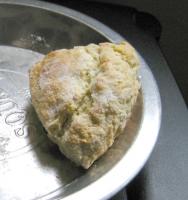I thought I could see some snow flakes in the air, but with the wind velocity, was hard to tell them from flying bits of junk.
To get going, I decided to make some scones to have with my tea. Thank goodness I went out for milk and fruit yesterday afternoon. This is the original recipe, from:
Sunset Cook Book of Breads, Lane Books, Menlo Park, CA, 1966.
Old-Fashioned Cream Scones
2 cups unsifted redular all-purpose flour
3 teaspoons baking powder
2 tablespoons sugar
1/2 teaspoon salt
4 tablespoons butter or margarine
2 eggs, beaten (reserve about 1 tablespoon of the egg white for brushing on top)
1/3 cup heavy cream
2 teaspoons sugar to sprinkle on top
Now for my version. First, I make a half recipe (four scones) which gives me two to have with my morning mug of tea plus two for snacking later. I use unbleached flour that I keep in the cupboard for making bread. I have found that butter can be successfully substituted for margarine in almost any recipe!
OK, time for a diversion. My great-grandfather (I sort of remember him from when I was a small child) was often quoted by family members as saying, “If you cooked a dried up horse turd in butter it would taste good!” That was long before people started worrying about trans-fatty acids.
I don’t keep heavy cream in the house, although sometimes I have half and half, so I substitute whole milk and add a bit more butter.
I cut the butter into the dry ingredients with a pastry blender, a D-shaped tool with a wooden handle and heavy wires for the curved part, originally gotten for making pie crusts. You can use other tools or a food processor to cut in the butter, or even your fingers if your hands are cool.
I usually sift the dry ingredients into a fairly large bowl, that way I can cut in the butter then knead the dough in it making cleanup easier. I often add dried fruit or nuts to the flour after cutting in the butter. Today I used dried cranberries (health food store version of Craisins™), but currents or raisins are good too.
I beat the egg and then mixed in the milk in a second smaller bowl. Instead of reserving egg white for the tops, I use the bit of egg and milk left in the bowl after I pour the liquid ingredients into the dry stuff instead.
For the frugal, instead of heating up the big oven, I shaped the dough into a disk and put it in a pie pan, cut it into four wedges with the same knife I used to cut the butter, then baked the scones in my toaster oven at 400°F.
Tip: set the scones on their sides to keep the bottoms crisp as they cool.

